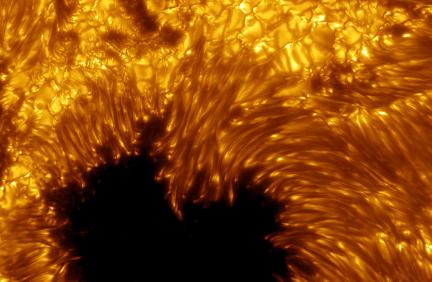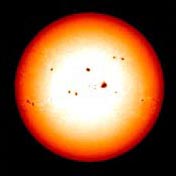 I have to admit this is my first direct lift right from Astronomy Picture of the Day (dating back to November 2002). Some recent images of Solar prominences and arcs are pretty close in quality if not surpass this, but I don’t think I have seen anything comparitively detailed of the actual surface like this. The image was acquired through the ground-based Swedish Solar Telescope located on the Canary Island of La Palma. Despite the ground-based operation, it still was able to make an image of the Sun that surpassed any of those taken by the observatories in orbit at that point in time.
I have to admit this is my first direct lift right from Astronomy Picture of the Day (dating back to November 2002). Some recent images of Solar prominences and arcs are pretty close in quality if not surpass this, but I don’t think I have seen anything comparitively detailed of the actual surface like this. The image was acquired through the ground-based Swedish Solar Telescope located on the Canary Island of La Palma. Despite the ground-based operation, it still was able to make an image of the Sun that surpassed any of those taken by the observatories in orbit at that point in time.
What is seen in the above image is a dark region known as a sunspot which is a planet sized area of unknown origin.  It has a much lower temperature than its surrounding areas and emits a tremendous amount of magnetic activity. Of course, any imaging the Sun in normal visible light with no photographic trickery would result in an entirely white image with no details at all. So the funny thing about these “dark spots” (see visible/white light image at left) is that they are actually blindingly bright to a human eye. It is only when we image these areas in comparitive contrast with the surrounding hotter areas do they appear as dark in photographs. These mysterious spots seem to also appear in abundance in 11 year cycles which also eludes any scientific explanation.
It has a much lower temperature than its surrounding areas and emits a tremendous amount of magnetic activity. Of course, any imaging the Sun in normal visible light with no photographic trickery would result in an entirely white image with no details at all. So the funny thing about these “dark spots” (see visible/white light image at left) is that they are actually blindingly bright to a human eye. It is only when we image these areas in comparitive contrast with the surrounding hotter areas do they appear as dark in photographs. These mysterious spots seem to also appear in abundance in 11 year cycles which also eludes any scientific explanation.